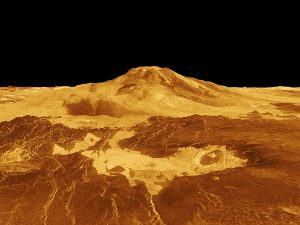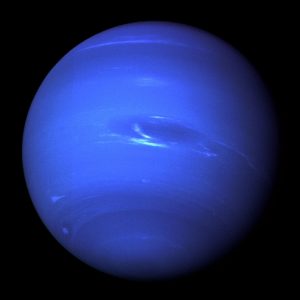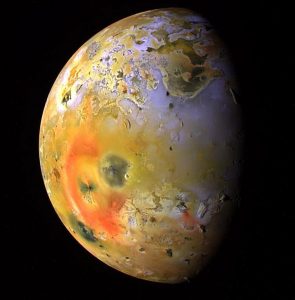Note: I actually wrote this in January to explain the background on an item I had put up for auction. It was deleted once the auction was over, but a reader wanted to be able to point someone at the text because he thought it was interesting. So here it is. –RC
It Was Truly Exciting to work at NASA’s Jet Propulsion Laboratory in 1989; I worked there from 1986 to 1996, when I resigned to work full time on This is True. In 1989, there had been no exploratory missions launched to other planets in 11 years. But that year, there were to be two interplanetary launches, plus an amazing encounter of a never-before-visited planet.
Magellan Launch to Venus

The Magellan spacecraft, also referred to as the Venus Radar Mapper, was a 1,035-kilogram (2,282 lb) robotic space probe launched on May 5, 1989, to map the surface of Venus by using synthetic aperture radar and to measure the planet’s gravitational field.
Why use radar to create computer-generated pictures of the planet? Because Venus is always covered by thick clouds, and that’s how we were able to see the surface for the first time. The resulting images are amazing; a sample is attached.
Magellan was the first interplanetary mission to be launched from a Space Shuttle (Atlantis), and the first spacecraft to test aerobraking as a method for circularizing its orbit on arrival. Magellan was the fifth successful NASA mission to Venus.
The spacecraft was designed and built by Martin Marietta, and the Jet Propulsion Laboratory managed the mission. Most of the Magellan probe was made up of spare parts from various previous missions, including the Voyager program, Galileo, Ulysses, and Mariner 9. The main body of the spacecraft was a Voyager spare. Because it was at Venus (read: close the the sun), it was powered by solar panels. On the other hand, the constant heating/cooling of the panels as the spacecraft orbited Venus degraded them quickly, and Magellan once it was approaching its end of life, it was purposefully slowly to lower it into the Venus atmosphere to burn it up, which happened October 13, 1994.
Voyager Encounters Neptune

Voyager 2 is still the only spacecraft to ever visit Neptune. Its closest approach was on August 25, 1989 — only 4,950 kilometres (3,080 mi) above Neptune’s north pole. I remember the encounter vividly, since there was such excitement: scores of TV satellite trucks competed for every possible parking spot on JPL’s campus to send the pictures back to a worldwide audience. And what a beautiful, deep-blue planet!
Voyager 2 discovered six new small moons orbiting Neptune’s equatorial plane, and they were named Naiad, Thalassa, Despina, Galatea, Larissa and Proteus. Only three of Neptune’s moons were photographed in detail: Proteus, Nereid, and Triton.
There are still no plans to visit Neptune again. Voyager 2 is currently nearly 11 billion miles away from Earth, and is the second-farthest human-made object from us (Voyager 1 is farthest, at 13.1 billion miles).
Galileo Launch to Jupiter
Jupiter was rated as the #1 priority in the Planetary Science Decadal Survey published in the summer of 1968. In the early 1970s, the first flybys of Jupiter were achieved by Pioneer 10 and Pioneer 11, and before the decade was out, Jupiter was also visited by the more advanced Voyager 1 and Voyager 2 spacecraft. What we learned from those flybys was so compelling, we decided to send an orbiter to spend more time there — Galileo, launched October 18, 1989, also by Space Shuttle Atlantis. It arrived at Jupiter on December 7, 1995, after gravitational assist flybys from Venus and Earth.

Built by JPL, the spacecraft traveled around Jupiter in elongated ellipses, each orbit lasting about two months. The differing distances from Jupiter afforded by these orbits allowed Galileo to sample different parts of the planet’s extensive magnetosphere. The orbits were designed for close-up flybys of Jupiter’s largest moons. Once the prime mission concluded, an extended mission started on December 7, 1997; the spacecraft made a number of flybys of Jupiter’s moons Europa and Io. The radiation environment near Io was very unhealthy for Galileo’s systems, and so these flybys were saved for the extended mission when loss of the spacecraft would be more acceptable, should that happen.
Galileo’s cameras were deactivated on January 17, 2002, after they had sustained irreparable radiation damage, but Galileo continued to return scientific data until it was deorbited.
Galileo also carried a probe, which separated from the main spacecraft on July 10, 1995, five months before its rendezvous with the planet. After a rough deceleration, the Descent Module started to return data to the main spacecraft orbiting high above Jupiter. The 339-kilogram (747 lb) probe was built by Hughes Aircraft Company, and measured about 1.3 meters (4.3 ft) across. Inside the probe’s heat shield, the Descent Module and its scientific instruments were protected from extreme heat and pressure during its high-speed journey into the Jovian atmosphere, entering at 47.8 kilometers per second (29.7 mi/s)
During the 57 minutes of data collecting, the probe returned some surprising data on Jupiter’s atmospheric conditions and composition.
Another really interesting aspect of the Galileo mission: astronomer Carl Sagan, pondering the question of whether life on Earth could be easily detected from space, devised a set of experiments in the late 1980s using Galileo’s remote sensing instruments during the mission’s first Earth flyby in December 1990. After data acquisition and processing, Sagan et al. published a paper in Nature in 1993 detailing the results of the experiment.
Galileo had indeed found what are now referred to as the “Sagan criteria for life.” These included strong absorption of light at the red end of the visible spectrum (especially over continents) which was caused by absorption by chlorophyll in photosynthesizing plants, absorption bands of molecular oxygen which is also a result of plant activity, infrared absorption bands caused by the ~1 micromole per mole of methane in Earth’s atmosphere (a gas which must be replenished by either volcanic or biological activity), and modulated narrowband radio wave transmissions uncharacteristic of any known natural source. Galileo’s experiments were thus the first ever controls in the newborn science of astrobiological remote sensing.
As with many such missions, Galileo’s ended when the spacecraft was purposefully sent into Jupiter’s atmosphere, destroying it, which occurred September 21, 2003.
– – –
Bad link? Broken image? Other problem on this page? Use the Help button lower right, and thanks.
This page is an example of my style of “Thought-Provoking Entertainment”. This is True is an email newsletter that uses “weird news” as a vehicle to explore the human condition in an entertaining way. If that sounds good, click here to open a subscribe form.
To really support This is True, you’re invited to sign up for a subscription to the much-expanded “Premium” edition:
Q: Why would I want to pay more than the minimum rate?
A: To support the publication to help it thrive and stay online: this kind of support means less future need for price increases (and smaller increases when they do happen), which enables more people to upgrade. This option was requested by existing Premium subscribers.
